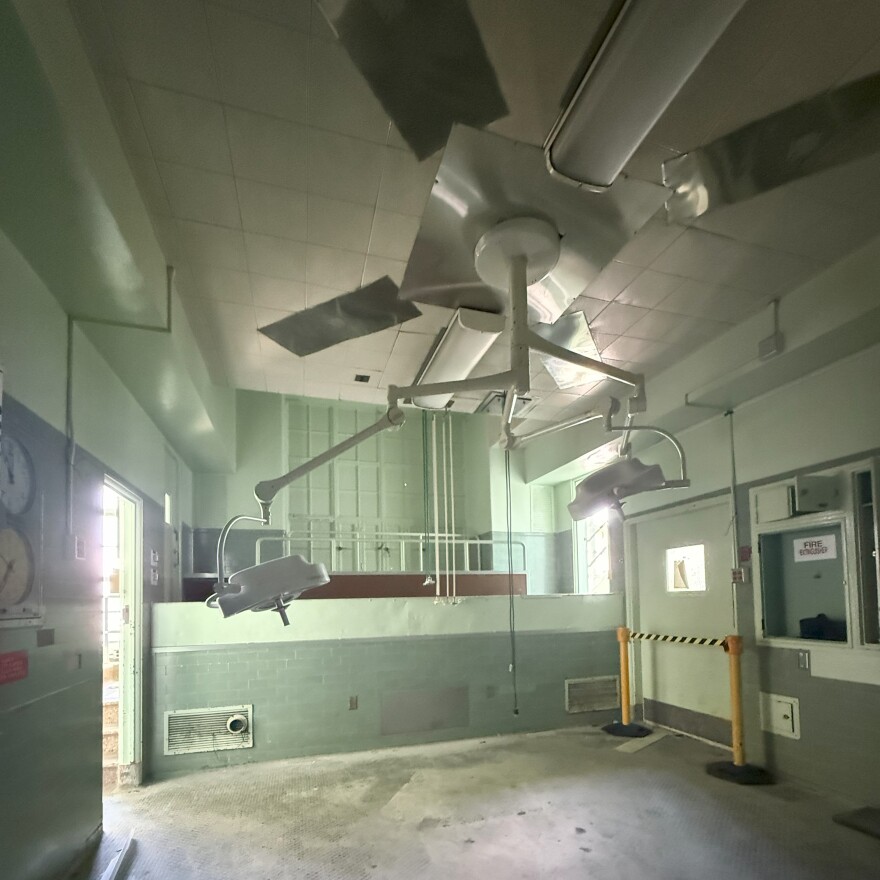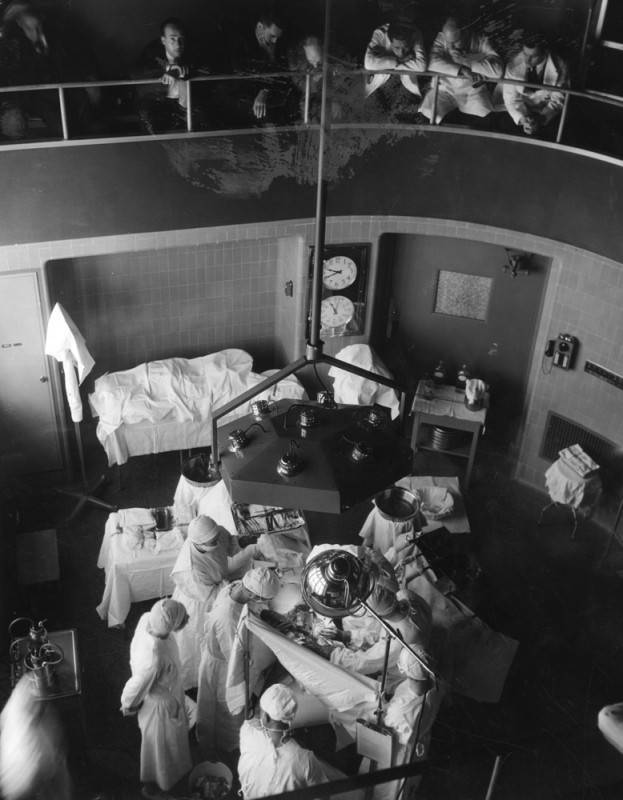Truth matters. Community matters. Your support makes both possible. LAist is one of the few places where news remains independent and free from political and corporate influence. Stand up for truth and for LAist. Make your year-end tax-deductible gift now.
Go inside LA’s old General Hospital before it turns from a spooky Art Deco time capsule into new housing

You’ve seen the goliath Art Deco structure if you’ve ever driven on the 5 Freeway near downtown Los Angeles. Or the opening sequence of one of the most famous soap operas.
Here at the old General Hospital building in Boyle Heights — sometimes referred to as “The Great Stone Mother” — the county has big plans to bring new life to a massive testament to health care for the most vulnerable.
When you walk up the steps to the old entrance, the towering, Art Deco structure, built in 1933, greets you with watchful statues. Front and center is the Angel of Mercy, flanked by greats of medicine, like Pasteur and Hippocrates.

And a stone etching reminds all who enter that this building was erected to care for people without charge “in order that no citizen of the county shall be deprived of health or life for lack of such care and services.”
Rosa Soto is executive director of the Wellness Center on the bottom floor, where people can receive mental health help or even take classes about healthy eating.
And this was her hospital as a kid.
“People have a connection to the building, whether they were born here, whether they were healed here. Or maybe they lost a loved one here. There’s a connection to the building that I think is important through the generations,” Soto told LAist during a recent tour.
The Wellness Center is like the beating heart of this old building. But travel up the elevator beyond the fourth floor, and it’s a different story.

Part of the facilities shut down after the building suffered damage in the 1994 Northridge earthquake. The hospital was fully shuttered in 2008 after a new one finished construction next door. The upper floors of this concrete colossus are like time capsules. With some vandalism and decay, they also feel a little post-apocalyptic.
With each floor, a time capsule
The 13th floor served as the jail ward, where incarcerated people received care. Long, dark corridors are cordoned off with metal bars. A frozen clock sits on the counter of a nurses station. And a red log book with 2008 on the cover contains the names of some of the last patients seen.
The next stop was the 15th floor. Operating rooms on this level stretch up three floors. Towering windows shed light on the pale green walls, surgical tables stuck in time, and steep stadium seating where doctors in training would observe medical procedures.

“Look at this theater. Look at the incredibleness of people that are learning in this suite and watching state-of-the-art, world-class surgeries occur right before their eyes as they’re learning,” Soto said.
Officials said they want to keep architectural elements like the tile flooring and large windows intact as developers adapt the space for housing. In July, the county made the move to apply to get this building on the National Register of Historic Places, which could clear the way for tax breaks.
“The plan is to really assess those historic elements that we want to preserve and sort [of] take it into a new opportunity. And then, whatever remains to see how we can maximize housing, how we can maximize services, workforce development, workforce housing,” Soto said.

The idea is to repurpose space in this more than one-million-square-foot building to make way for 800 units or more of housing, about a third of which would be affordable.
Urban planner James Rojas grew up in Boyle Heights. He said a lot of people he’s known over the years were born here.
For him, the massive building is an important part of the eastside landscape.
“I think it’s great that they’re preserving that building because it’s such an icon from the 1930s,” he said.
One of L.A.’s most prominent examples of the Art Deco style, the hospital was designed by the Allied Architects’ Association of Los Angeles, which also designed downtown’s Hall of Justice.
Rojas joked that the aging behemoth might be haunted, with so many lives beginning and ending there. But he’s drawn to the cultural values that were at the heart of its founding.
“You know, they built this hospital for the poor people of L.A. County,” Rojas said.

A complicated past
While countless patients who could not afford care elsewhere received treatment on the campus, some over the years believed they were actually harmed.
In the late 1960s and early ‘70s, hundreds of women, many of whom did not speak English, were sterilized at the medical center.
Historian Virginia Espino produced the 2015 documentary, “No Más Bebés,” which told the story of a group of women who sued the state and other entities in 1975, alleging that they were coerced into tubal ligation procedures.
“Many of them believed that maybe what happened to them was their fault because they didn’t speak English proficiently or they didn’t understand medical language,” Espino said. “So they took responsibility for that when, in actuality, something was happening to them by this pattern of practice by the hospital at that time.”
The women never received financial restitution. In 2018, the county approved a motion to issue a formal apology letter to the women who received the procedures.
“I wouldn’t say that they received justice with that apology, but they received validation, which was very important to them and their children,” Espino said. She also applauded the county’s move to place an art installation on the medical campus, which serves to remind visitors of what happened to the women decades ago.

What’s next
The county already dedicated some $134 million to get a seismic retrofit and cleanup work started at the old building. Officials said it will take a public-private partnership and financing before the housing units there are realized.
What about L.A. County’s budget crisis? How might that affect the work at the old General Hospital? The county said the initial $134 million investment has been secured and is not subject to clawbacks.
And plans for this sprawling campus don’t stop at the Art Deco structure. They spread out dozens of acres, turning the area in the shadow of General Hospital into a city within a city.
There eventually will be hundreds of mental health treatment beds here, in close proximity to the Los Angeles County-USC Medical Center that replaced the old hospital.
The Los Angeles General Medical Center’s Restorative Care Village already has 160 mental health treatment beds, and more than 100 additional beds are in the works.
Supervisor Hilda Solis said the idea to revitalize this campus goes back the better part of a decade, with roughly a hundred meetings held with the community. Many said they didn’t want to lose the 1933 building in the process.

“The community wanted to preserve that,” Solis told LAist. “They didn’t want to see it torn down. And to be honest ... I understand that. There’s history there, whether it’s good, bad, indifferent.”
As the county struggles to meet the massive needs for housing and mental health care, Solis said she’d like to see every district look at ways of repurposing spaces like this across the region.
“The more people realize that it is something that is so important to our history in L.A. County, to preserve and to continue to support, I hope that more people will be inspired to help us,” Solis said.
Officials said they hope the cleanup work and partial seismic retrofit in the old building will be completed within two years.








